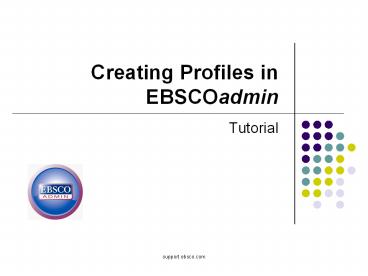Creating Profiles in EBSCOadmin - PowerPoint PPT Presentation
1 / 11
Title:
Creating Profiles in EBSCOadmin
Description:
EBSCOadmin Tutorial support.ebsco.com Welcome to the Creating Profiles in EBSCOadmin tutorial. A Profile can contain one or more databases, is attached to a User ... – PowerPoint PPT presentation
Number of Views:87
Avg rating:3.0/5.0
Title: Creating Profiles in EBSCOadmin
1
Creating Profiles inEBSCOadmin
- Tutorial
2
Welcome to the Creating Profiles in EBSCOadmin
tutorial. A Profile can contain one or more
databases, is attached to a User Group, and
allows you to customize the databases,
collections, limiters, expanders, search screens,
and other features your users see within
EBSCOhost.
3
Some administrators set up multiple profiles,
each containing one database, in order to provide
their users with access to single databases from
a secure library home page. Others create
separate profiles in order to highlight different
funding sources or branding needs.
4
The process used to create a new profile is
simple, when you follow these stepsFrom the
Customize Services tab, click on the Profile
Maintenance link.
5
Click on the Add a New Profile link.
6
Fill in the blank fields with terms that will
help you identify the profile later and select
the Interface you wish to use from the drop-down
menu. Note The Interface drop-down list contains
every interface that is compatible with the
database(s) in your profile.Click Submit, then
click the Back to Customize Services link.
7
To add databases to your new profile, select it
from the drop-down list next to Choose Profile,
and then click on the Databases sub-tab.
8
From the Show drop-down menu, select All to
display all databases that are available to your
institution. In the Enabled column, click the On
radio button for each database you would like to
enable in your profile. If you would like to set
any databases to be selected by default, you can
do that in the Default to Selected column.
9
After making your selections, scroll down to the
bottom of the database list and click Submit.
10
Click on the Searching sub-tab to make changes to
the settings for your new profile. See our
Customize Services tutorial for tips on how best
to use the many features and settings included
under the Searching sub-tab.
11
Click the Help link to view the online User
Guide, or visit http//support.ebsco.com to
search our Knowledge Base of FAQs, view
additional tutorials, download support materials
such as Help Sheets, or contact Technical
Support. This concludes the Creating Profiles in
EBSCOadmin tutorial.

